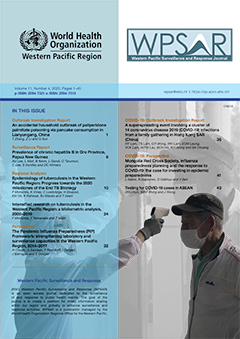Epidemiology of tuberculosis in the Western Pacific Region: Progress towards the 2020 milestones of the End TB Strategy
DOI:
https://doi.org/10.5365/wpsar.2020.11.3.002Abstract
Since 2015, the End TB Strategy and the Regional Framework for Action on Implementation of the End TB Strategy in the Western Pacific 2016–2020 have guided national tuberculosis (TB) responses in countries and areas of the Region. This paper provides an overview of the TB epidemiological situation in the Western Pacific Region and of progress towards the 2020 milestones of the Strategy. A descriptive analysis was conducted of TB surveillance and programme data reported to WHO and estimates of the TB burden generated by WHO for the period 2000–2018. An estimated 1.8 million people developed TB and 90 000 people died from it in the Region in 2018. Since 2015, the estimated TB incidence rate and the estimated number of TB deaths in the Region decreased by 3% and 10%, with annual reduction rates of 1.0% and 3.4%, respectively. With current efforts, the Region is unlikely to achieve the 2020 milestones and other targets of the Strategy. Major challenges include: (1) wide variation in the geographical distribution and rate of TB incidence among countries; (2) a substantial proportion (23%) of TB cases that remain unreached, undiagnosed or unreported; (3) insufficient coverage of drug susceptibility testing (51%) for bacteriologically confirmed cases and limited use of WHO-recommended rapid diagnostics (11 countries reported < 60% coverage); (4) suboptimal treatment outcomes of TB (60% of countries reported < 85% success), of TB/HIV co-infection (79%) and of multidrug- or rifampicin-resistant TB (59%); (5) limited coverage of TB preventive treatment among people living with HIV (39%) and child contacts (12%); and (6) substantial proportions (35–70%) of TB-affected families facing catastrophic costs. For the Region to stay on track to achieve the End TB Strategy targets, an accelerated multisectoral response to TB is required in every country.
References
World Health Organization. Global Tuberculosis Report 2019 [Internet]. Geneva; 2019. Available from: https://apps.who.int/iris/bitstream/handle/10665/329368/9789241565714-eng.pdf?ua=1
World Health Organization. The Sixty-Seventh World Health Assembly. Global strategy and targets for tuberculosis prevention, care and control after 2015 [Internet]. Geneva; 2014. Available from: https://apps.who.int/gb/ebwha/pdf_files/WHA67-REC1/A67_2014_REC1-en.pdf
World Health Organization. Multisectoral Accountability Framework to Accelerate Progress to End Tuberuculosis [Internet]. Geneva; 2019. Available from: https://www.who.int/tb/WHO_Multisectoral_Framework_web.pdf?ua=1
World Health Organization. Global tuberculosis database [Internet]. Geneva; 2020. Available from: https://www.who.int/tb/country/data/download/en/
Glaziou P. Predicted impact of the COVID-19 pandemic on global tuberculosis deaths in 2020. medRxiv. 2020;000:2020.04.28.20079582.
World Health Organization Regional Office for the Western Pacific. Regional Framework for Action on Implementation of the End TB Strategy in the Western Pacific, 2016-2020 [Internet]. Manila; 2016. Available from: https://iris.wpro.who.int/bitstream/handle/10665.1/13131/9789290617556_eng.pdf
Rahevar K, Fujiwara PI, Ahmadova S, Morishita F, Reichman LB. Implementing the End TB Strategy in the Western Pacific Region: Translating vision into reality. Respirology. 2018;23(8):735–42.
Glaziou P, Dodd PJ, Dean A, Floyd K. Methods used by WHO to estimate the globalburden of TB disease [Internet]. 2019. Available from: https://www.who.int/tb/publications/global_report/tb19_technical_appendix.pdf?ua=1
World Health Organization. Definitions and reporting framework for tuberculosis - 2013 revision (updated December 2014 and January 2020) [Internet]. Geneva; 2013. Available from: https://apps.who.int/iris/bitstream/handle/10665/79199/9789241505345_eng.pdf?sequence=1
Marais BJ, Lönnroth K, Lawn SD, Migliori GB, Mwaba P, Glaziou P, et al. Tuberculosis comorbidity with communicable and non-communicable diseases: Integrating health services and control efforts. Lancet Infect Dis. 2013;13(5):436–48.
Trinidad RM, Brostrom R, Morello MI, Montgomery D, Thein CC, Gajitos ML, et al. Tuberculosis screening at a diabetes clinic in the Republic of the Marshall Islands. J Clin Tuberc Other Mycobact Dis. 2016;5:4–7.
Viney K, Cavanaugh J, Kienene T, Harley D, Kelly PM, Sleigh A, et al. Tuberculosis and diabetes mellitus in the Republic of Kiribati: A case-control study. Trop Med Int Heal. 2015;20(5):650–7.
World Health Organization. Understanding and using tuberculosis data [Internet]. Geneva; 2014. Available from: https://apps.who.int/iris/bitstream/handle/10665/129942/9789241548786_eng.pdf;jsessionid=A3E2F29EE3F8C50C70DC7D24AC58A7BD?sequence=1
World Health Organization. Systematic screening for active tuberculosis; Principles and recommendations [Internet]. Geneva; 2013. Available from: https://apps.who.int/iris/bitstream/handle/10665/84971/9789241548601_eng.pdf?sequence=1
The Global Fund Data Explorer. Available from: https://data.theglobalfund.org/investments/home
World Health Organization. Epidemiological reivew for tuberculosis in the Philippines, 2019 (unpublished). Manila; 2019.
World Health Organization & National TB Center. Epidemiological report for tuberculosis in Lao PDR, 2019 (unpublished). 2019.
World Health Organization. Epidemiological review for tuberculosis in Cambodia, 2018 (Unpublished). 2018.
Nishikiori N, Morishita F. Using tuberculosis surveillance data for informed programmatic decision-making. West Pacific Surveill Response J [Internet]. 2013;4(1):1–3. Available from: http://www.wpro.who.int/wpsar/volumes/04/1/2013_ED_Nishikiori/en/index.html
Manuela R, D. M. Freitas M, van der Land J. Optimizing and understanding the use of Xpert MTB/RIF® testing [Internet]. 2019. Available from: https://www.challengetb.org/publications/tools/briefs/CTB_Technical_Brief_GeneXpert.pdf
World Health Organization. Handbook for the use of digital technologies to support tuberculosis medication adherence [Internet]. Geneva; 2017. Available from: https://apps.who.int/iris/bitstream/handle/10665/259832/9789241513456-eng.pdf?sequence=1
National TB Control Programme. Epidemiological reivew for tuberculosis in Viet Nam, 2019 (unpubilshed). 2019.
Aia P, Wangchuk L, Morishita F, Kisomb J, Yasi R, Kal M, et al. Epidemiology of tuberculosis in Papua New Guinea: analysis of case notification and treatment-outcome data, 2008-2016. West Pacific Surveill Response J [Internet]. 2018;9(2):1–11. Available from: www.wpro.who.int/wpsar
Uchimura K, Ngamvithayapong-Yanai J, Kawatsu L, Ohkado A, Yoshiyama T, Shimouchi A, et al. Characteristics and treatment outcomes of tuberculosis cases by risk groups, Japan, 2007-2010. West Pacific Surveill response J WPSAR [Internet]. 2013 Jan [cited 2015 Apr 1];4(1):11–8. Available from: http://www.pubmedcentral.nih.gov/articlerender.fcgi?artid=3729108&tool=pmcentrez&rendertype=abstract
Negin J, Abimbola S, Marais BJ. Tuberculosis among older adults – time to take notice. Int J Infect Dis. 2015;32:135–7.
Li J, Chung PH, Leung CLK, Nishikiori N, Chan EYY, Yeoh EK. The strategic framework of tuberculosis control and prevention in the elderly: A scoping review towards End TB targets. Infect Dis Poverty. 2017;6(1):1–12.
Overcoming key barriers to scale up tuberculosis preventive treatment (TPT); A Call to Action [Internet]. 2020. Available from: https://www.who.int/tb/CalltoactionTPT_scaleup.pdf?u=f093a7c38a3780cd9504f8d9d&id=135bdee6af&e=09bced52fa
World Health Organization. WHO operational handbook on tuberculosis, module 1: Prevention, Tuberculosis preventive treatment [Internet]. Geneva; 2020. Available from: https://apps.who.int/iris/bitstream/handle/10665/331525/9789240002906-eng.pdf
Reuter A, Seddon JA, Marais BJ, Furin J. Preventing tuberculosis in children: A global health emergency. Paediatr Respir Rev [Internet]. 2020;(xxxx). Available from: https://doi.org/10.1016/j.prrv.2020.02.004
Viney K, Islam T, Binh Hoa N, Morishita F, Lönnroth K. The Financial Burden of Tuberculosis for Patients in the Western-Pacific Region. Trop Med Infect Dis. 2019;4(94):1–12.

